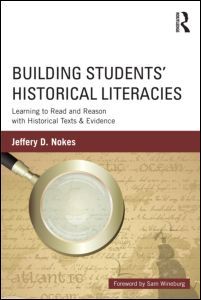Description
Building Students' Historical Literacies
Learning to Read and Reason with Historical Texts and Evidence
Author: Nokes Jeffery
Language: English
Subjects for Building Students' Historical Literacies:
Keywords
History Teachers; History Education; Historical Thinking; historical literacies; Graphic Organizer; teaching history; Political Cartoons; teaching historical historical literacies; Background Knowledge; social studies methods; Stanford History Education Group; literacies of historical inquiry; Historical Literacy Instruction; Fi Ve; Historical Fi Ction; Historical Literacies; Traditional History Instruction; History Classrooms; World War Ii Memorial; Non-traditional Texts; Ancestral Pueblo; Younger Men; Historical Em
Approximative price 63.89 €
In Print (Delivery period: 13 days).
Add to cartPublication date: 11-2012
Support: Print on demand
Approximative price 167.95 €
In Print (Delivery period: 13 days).
Add to cartPublication date: 11-2012
Support: Print on demand
Description
/li>Contents
/li>Biography
/li>
How can teachers incorporate the richness of historical resources into classrooms in ways that are true to the discipline of history and are pedagogically sound? This book explores the notion of historical literacy, adopts a research-supported stance on literacy processes, and promotes the integration of content-area literacy instruction into history content teaching. It is unique in its focus on the discipline-specific literacies of historical inquiry. Addressing literacy from a historian?s rather than a a literacy specialist?s point of view, this book surveys a broad range of texts including those that historians and non-historians both use and produce in understanding history; and includes a wide variety of practical instructional strategies immediately available to teachers.
History teachers who read this book will receive the practical tools they need in order to help their students reach the national standards for history teaching. With the recent inclusion of a historical literacy component of the English Language Arts Common Core Standards Initiative, this book is also highly relevant to English, language arts, and reading teachers, who are expected, under the new guidelines, to engage their students in historical reading and writing.
Visit historicalliteracies.byu.edu for additional information and resources on teaching historical literacies.
Part 1: Historical Literacies 1. Building historical literacies 2. Defining historical literacies 3. Teaching historical literacies 4. Developing an appropriate epistemic stance for working with multiple texts Part 2: Fluency with strategies and evidence 5. Using historians’ heuristics for working with primary sources 6. Helping students make inferences with artifacts 7. Developing metaconceptual understanding with visual evidence8. Developing historical empathy and perspective taking through historical fiction 9. Fostering healthy skepticism using textbooks and secondary sources 10. Avoiding reductionist thinking with audio and video texts 11. Building an argument with quantitative historical evidence Part 3: Putting it all together 12. Engaging in critical intertextual analysis with multimodal texts 13. Finding a pattern in building historical literacies
Jeffery D. Nokes is Assistant Professor, Department of History, Brigham Young University, USA.




